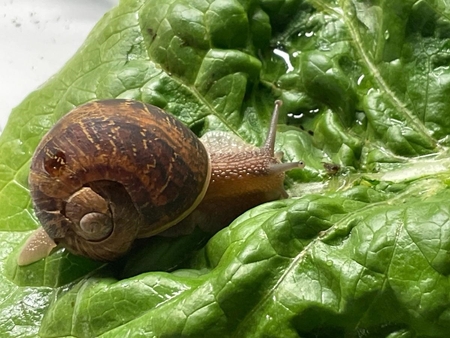
Good Natured: Esther Duncan the Hitchhiking Snail
Growing up we had the best neighbors a kid could hope for: Harry and Esther Duncan.
Uncle Harry, as we called him, lost his parents at a young age and rather than grow up in an orphanage, he ran away and, I kid you not, joined the circus. So began a lifelong affiliation with entertainment and amusements which meant, for him, membership in the Showmen's League of America and, for us, a new best friend who had connections all over Chicagoland. Museums, ball parks, theme parks and circuses were just a few of the amazing destinations we experienced whenever Uncle Harry said, “C'mon kids, let's go for a ride!"
Aunt Esther, though she had her hands full with Harry, nonetheless exerted a powerful influence as well. She taught us how to identify dozens of birds; how to respect insects, especially bees; how to set a table (both casual and formal); and two essential skills from her youth, how to shoot a BB gun and saddle a horse!
But the best part of spending time with the Duncans was listening to their stories: How Esther was born in 1914 on a farm in upstate New York…during a Valentine's Day blizzard; how Harry lied about his age to join the Marines. But my favorite one of all was Esther's retelling of what might have been her greatest adventure: Hitchhiking her way from Modesto, CA back home to Illinois—a circuitous trip of over 2,500 miles and three dozen rides.
Now, to be perfectly honest, it's been a long time since I've thought about Uncle Harry and Aunt Esther. They moved away in the mid-1970s, first to Florida and then to Wisconsin. And while my folks stayed in touch with them, I did not.
But the other day, these and many other memories came flooding back, courtesy of, of all things, a snail.
More specifically, it was a hitchhiking snail—one that started out in California and ended up in Illinois, just like Aunt Esther. But unlike Esther's escapade, which cost her $5 and some change, the snail traveled scot-free courtesy of a truckload of landscaping plants.
Also unlike Esther, who arrived in Illinois unscathed, the snail sustained an injury during its journey. Its shell was partially crushed. But while this calamity could have resulted in an untimely end, in this snail's case its trauma was also its salvation. It was brought to my friend Peggy Anesi, a University of Illinois Extension naturalist in DeKalb County, in the hopes she could help. And help she did!
Peggy set up a terrarium and at first named the snail Turbo but then, after hearing Esther's story, renamed her new pet Esther Duncan. It's particularly appropriate because Esther is a feminine name and Duncan, masculine, and terrestrial snails like this one are hermaphroditic, that is, they possess both male and female parts.
Ensconced in a warm, humid, indoor environment, Esther Duncan today is thriving, and naturalist Peggy is thrilled to have a novel and easily observable study subject. Her observations so far include that:
Esther is big—at least as big around as a half dollar—and decidedly nocturnal. I was surprised by this at first but then, thinking it through, realized that's what terrestrial snails need to be to avoid drying out in the sun.
Esther excels at the production of slime, a substance essential to snail survival. Part glue and part lubricant, it's made up of proteins, enzymes, peptides and trace minerals and helps with hydration, locomotion and even communication—slime trails are how snails find each other. (Fun fact: Snail slime has long been a part of traditional Chinese medicine, and ancient Greeks used it to reduce inflammation. It's still in use today, in some types of skin products, but it's labeled as “snail mucin" and the ingredient list says “snail secretion filtrate" rather than “mucus" or “slime.")
Esther seems untroubled by the visible fracture to her/his shell, and feeds voraciously on romaine lettuce and other vegetable vittles. Elimination occurs regularly too, so it seems that everything inside the shell is in good working order.
What Peggy and I have both been working on, but have yet to resolve, is exactly what species Esther Duncan is. I'm leaning toward Cornu aspersum, the European brown snail, which has been introduced widely because they are, frankly, delicious. Can you say escargot?
Yet they're also considered invasive. California has had them since the 1850s, and they do hitchhike regularly in shipments of plants. We're continuing to work on this ID exercise, while also exploring the impact that inadvertently introduced species can have on the ecosystems where they end up.
Next week: We take a look at some of our area's most notorious hitchhikers.
Pam Otto is the outreach ambassador for the St. Charles Park District and can be reached at potto@stcparks.org.

